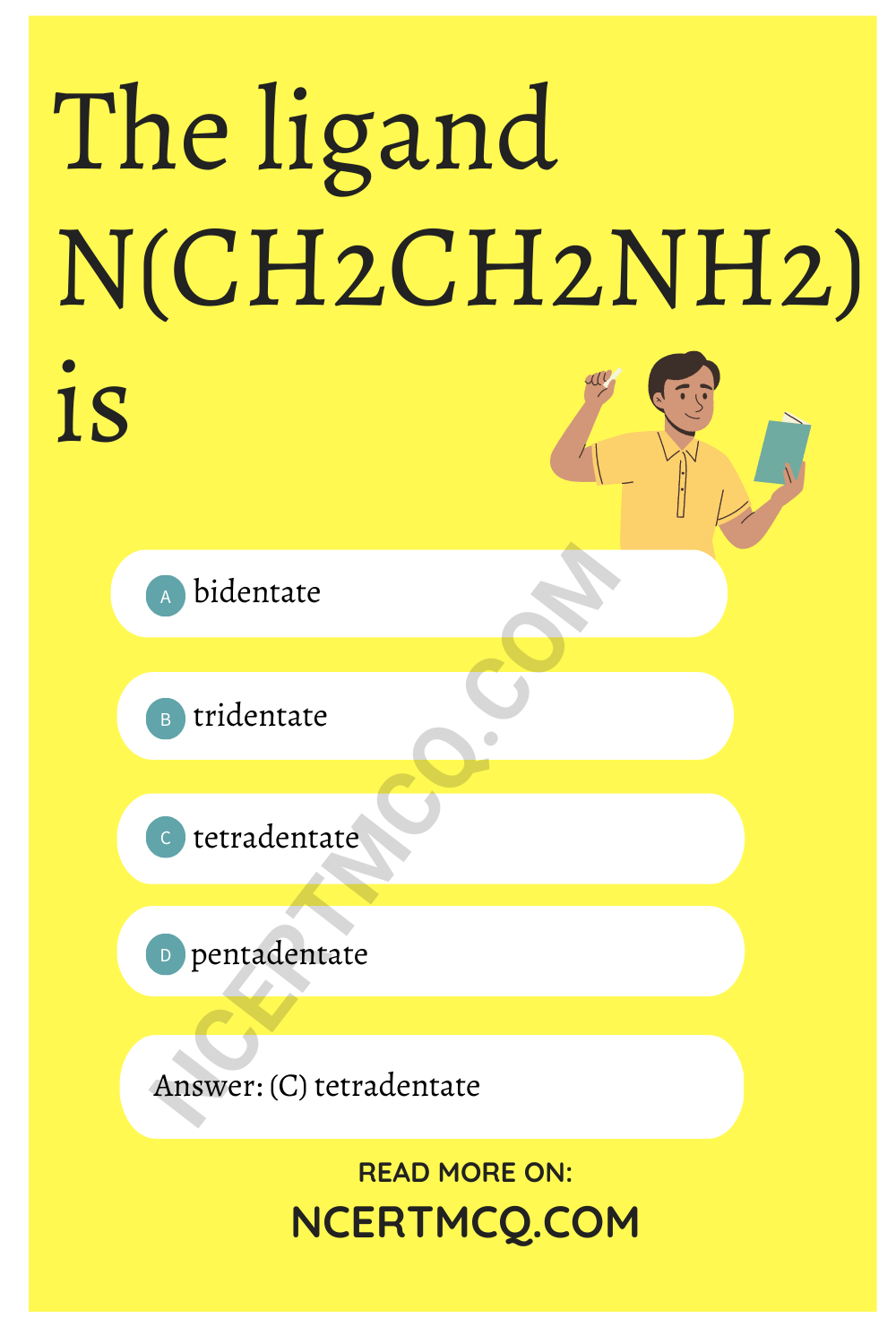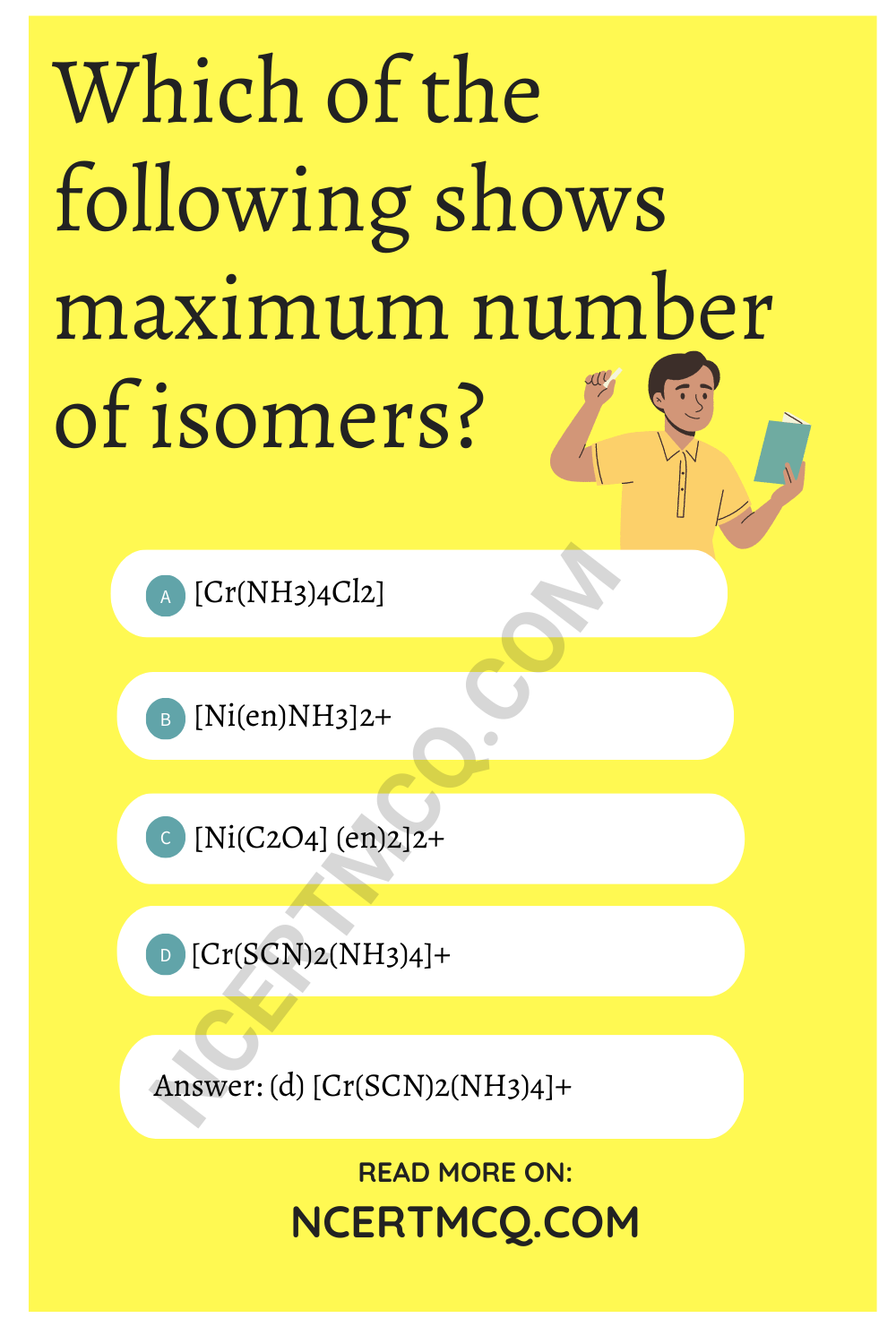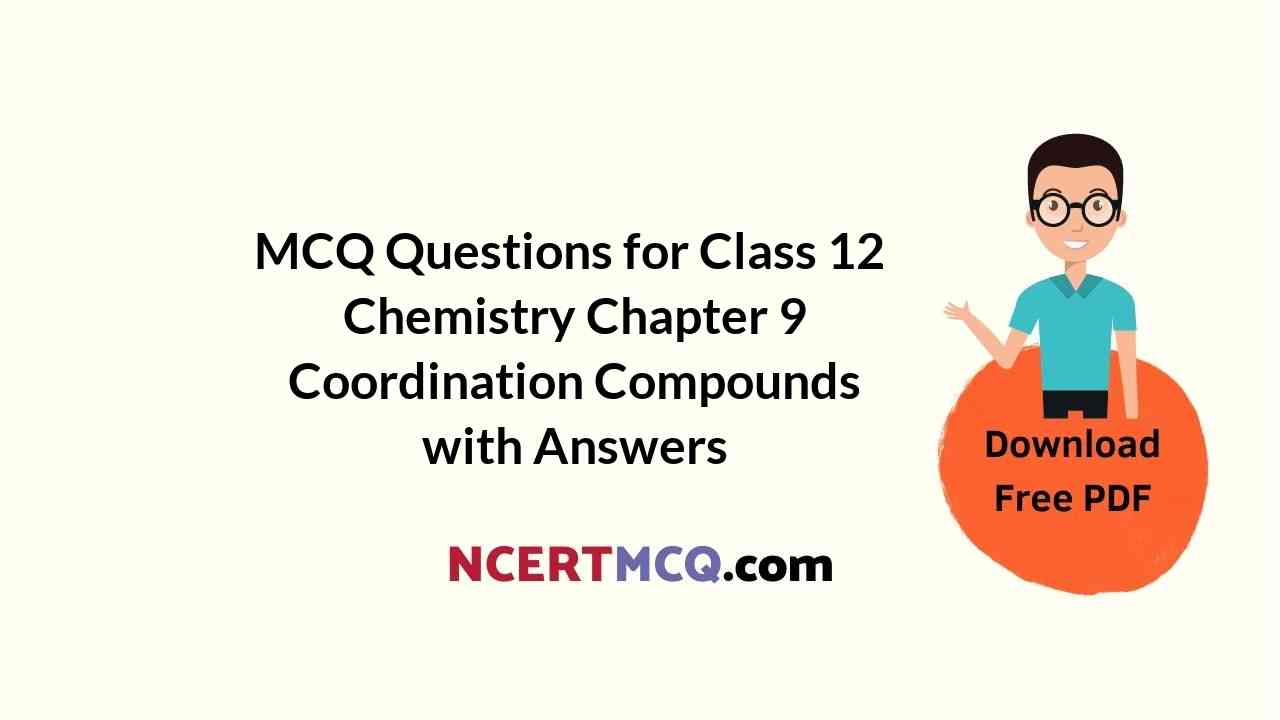Check the below NCERT MCQ Questions for Class 12 Chemistry Chapter 9 Coordination Compounds with Answers Pdf free download. MCQ Questions for Class 12 Chemistry with Answers were prepared based on the latest exam pattern. We have provided Coordination Compounds Class 12 Chemistry MCQs Questions with Answers to help students understand the concept very well.
Class 12 Chemistry Chapter 9 MCQ With Answers
Chemistry Class 12 Chapter 9 MCQs On Coordination Compounds
Coordination Compounds MCQ With Answers Pdf Question 1.
K2[Fe(CN)6] is a/an
(a) double salt
(b) complex salt
(c) acid
(d) base
Answer
Answer: (b) complex salt
Coordination Compounds Class 12 MCQ Question 2.
Which of the following compounds has tetrahedral geometry?
(a) [Ni(CN)4]2-
(b) [Pd(CN)4]2-
(c [PdCl4]2-
(d) [NiCl4]2-
Answer
Answer: (d) [NiCl4]2-
Coordination Is MCQ Class 12 Question 3.
The number of possible isomers for the complex
|Co(C2O4)2 (NH3)2|
(a) 1
(b) 2
(c) 3
(d) 4
Answer
Answer: (b) 2
Coordination Compounds MCQ Question 4.
The oxidation state of nickel in |(Ni(CO4)| is
(a) 1
(b) 4
(c) 2
(d) 3
Answer
Answer: (b) 4
MCQ On Coordination Compounds Question 5.
According to Werner’s theory of coordination compounds
(a) Primary valency is ion isable
(b) Secondary valency is ionisable
(c) Primary and secondary valencies are lonisable
(d) Neither primary nor secondary valency ¡s ionisable
Answer
Answer: (a) Primary valency is ion isable
MCQ Of Coordination Compounds Class 12 Question 6.
Ammonia acts as a very good ligand but ammonium ion does not form complexes because
(a) NH3 isa gas while NH\(_{4}^{+}\) is in liquid form.
(b) NH3 undergoes sp3 hybridisatiort while NH\(_{4}^{+}\) undergoes sp3 d hybndisation
(c) NH\(_{4}^{+}\) ion does not have any lone pair of electrons
(d) NH\(_{4}^{+}\) ion has one unpaired electron while NH3 has two unpaired electrons
Answer
Answer: (c) NH\(_{4}^{+}\) ion does not have any lone pair of electrons
Coordination Compounds MCQ With Answers Question 7.
The ligand N(CH2CH2NH2) is
(a) bidentate
(b) tridentate
(c) tetradentate
(d) pentadentate
Answer
Answer: (c) tetradentate

Coordination Chemistry MCQ Question 8.
Which of the following is a tridentate ligand?
(a) EDTA4+
(b) (COO)\(_{2}^{2-}\)
(c) dien
(d) NO\(_{2}^{-}\)
Answer
Answer: (c) dien
Coordination Chemistry MCQ Questions And Answers Pdf Question 9.
Among the following which arc ambidentate ligands?
(i) SCN–
(ii) NO\(_{3}^{-}\)
(iii) NO\(_{2}^{-}\)
(iv) C2O\(_{4}^{2-}\)
(a) (i) and (iii)
(b) (i) and (iv)
(c) (ii) and (iii)
(d) (ii) and (iv)
Answer
Answer: (a) (i) and (iii)
MCQs On Coordination Compounds Question 10.
Which of the following ligands form a chelate?
(a) Acetate
(b) Oxalate
(c) Cyanide
(d) Ammonia
Answer
Answer: (b) Oxalate
Coordination Chemistry MCQ With Answers Question 11.
Which of the following is not a neutral ligand?
(a) H2O
(b) NH3
(c) ONO
(d) CO2
Answer
Answer: (c) ONO
MCQ Questions On Coordination Compounds Question 12.
Which of the following ligands will not show chelation?
(a) EDTA
(b) DMG
(c) Ethene-1, 2-diamine
(d) SCN–
Answer
Answer: (d) SCN–
MCQ On Coordination Chemistry Question 13.
The complex ion which has no d-electrons in the central metal atom is
(a) [MnO4]–
(b) [Co(NH3)6]3-
(c) [Fe(CN)6]3-
(d) [Cr(H2O)6]3+
Answer
Answer: (a) [MnO4]–
Coordination Compound MCQ Question 14.
The correct IUPAC name of the coordination compound K3|Fe(CN)5NO| is
(a) Potassium pentacyanonitrosylferrate (II)
(b) Potassium pentacyanonitroferrate (II)
(c) Potassium nitritopentacyanoferrate (IV)
(d) Potassium nitritepentacynanoiron (II)
Answer
Answer: (a) Potassium pentacyanonitrosylferrate (II)
Coordination Compounds MCQs Question 15.
The correct IUPAC name of the following compound is |Cr(NH3)5(NCS)||ZnCl4|
(a) Penta amine isothiocyanato chromium (III) tetrachlorozincate (II)
(b) Penta amine isothicocyanatezinc chloridechromate (III)
(c) Penta amine isothicoyanato chromate (II)
(d) isothiocyanatopenta amine chromium (II) zinc chloride (IV)
Answer
Answer: (a) Penta amine isothiocyanato chromium (III) tetrachlorozincate (II)
Question 16.
Correct formulae of tetraaminechloronitroplatinum (IV) sulphate can be written as
(a) [Pt(NH3)4 (ONO) Cl]SO4
(b) [Pt(NH3)4Cl2NO2]2
(c) [Pt(NH3)4 (NO2) Cl]SO4
(d) [PtCl(ONO)NH3(SO4)]
Answer
Answer: (c) [Pt(NH3)4 (NO2) Cl]SO4
Question 17.
Which of the following isomers will give white precipitate with BaCl2 solution?
(a) [CO(NH3)5SO4]Br
(b) [CO(NH3)5Br]SO4
(c) [CO(NH3)4(SO4)2]Br
(d) [CO(NH3)4(SO4)]
Answer
Answer: (c) [CO(NH3)4(SO4)2]Br
Question 18.
|Pt(NH3)4| |CuCl4| and |Cu(NH3)4||PtCl4| are known as
(a) ionisation isomers.
(b) coordination isomers
(c) linkage isomers
(d) polymerisation isomers
Answer
Answer: (b) coordination isomers
Question 19.
The name of the linkage isomer of |C0(NH3)5NO2|Cl2 will be
(a) pentaammonotrocobalt (II) chloride
(b) pentaaminenitrochloridecobaltate (III)
(c) pentaamminenitritocobalt (III) chloride
(d) pentanitrosoamminechlorocobaltate(III)
Answer
Answer: (c) pentaamminenitritocobalt (III) chloride
Question 20.
Which of the following complex species is not expected to exhibit optical isomerism?
(a) [Co(en) (NH3)2Cl2]+
(b) [Co(en)3]3+
(c)[Co(en)2Cl2]
(d) [Co(NH3)3Cl3]
Answer
Answer: (d) [Co(NH3)3Cl3]
Question 21.
Which of the following compounds exhibits linkage isomerism?
(a) [Co(en)3]Cl3
(b) [Co(NH3)6] [Cr(en)3]
(c) [Co(en)2(NO2)CI]Br
(d) [Co(NH3)5CI]Br2
Answer
Answer: (c) [Co(en)2(NO2)CI]Br
Question 22.
Which of the following will not show geometrical isomerism?
(a) [Cr(NH3)4Cl2]Cl
(b) [Co(en)2Cl2]Cl
(c) [(Co(NH3)5NO2]Cl2
(d) [Pt(NH3)2Cl2]
Answer
Answer: (c) (Co(NH3)5NO2]Cl2
Question 23.
Which of the following shows maximum number of isomers?
(a) [Cr(NH3)4Cl2]
(b) [Ni(en)NH3]2+
(c) [Ni(C2O4] (en)2]2+
(d) [Cr(SCN)2(NH3)4]+
Answer
Answer: (d) [Cr(SCN)2(NH3)4]+

Question 24.
For the square planar complex |Mabcd| where M is the central atom and a, b. c, d are monodentate ligands, the number of possible geometrical isomers are
(a) 1
(b) 2
(c) 3
(d) 4
Answer
Answer: (c) 3
Question 25.
The hybridisation involved in [Co(C2O4)3]3- is
(a) sp3d2
(b) sp3d3
(c) dsp3
(d) d2sp3
Answer
Answer: (d) d2sp3
We hope the given NCERT MCQ Questions for Class 12 Chemistry Chapter 9 Coordination Compounds with Answers Pdf free download will help you. If you have any queries regarding Coordination Compounds CBSE Class 12 Chemistry MCQs Multiple Choice Questions with Answers, drop a comment below and we will get back to you soon.
Class 12 Chemistry MCQ:
- The Solid State Class 12 MCQ
- Solutions Class 12 MCQ
- Electrochemistry Class 12 MCQ
- Chemical Kinetics Class 12 MCQ
- Surface Chemistry Class 12 MCQ
- General Principles and Processes of Isolation of Elements Class 12 MCQ
- The p-Block Elements Class 12 MCQ
- The d-and f-Block Elements Class 12 MCQ
- Coordination Compounds Class 12 MCQ
- Haloalkanes and Haloarenes Class 12 MCQ
- Alcohols, Phenols and Ethers Class 12 MCQ
- Aldehydes, Ketones and Carboxylic Acids Class 12 MCQ
- Amines Class 12 MCQ
- Biomolecules Class 12 MCQ
- Polymers Class 12 MCQ
- Chemistry in Everyday Life Class 12 MCQ
